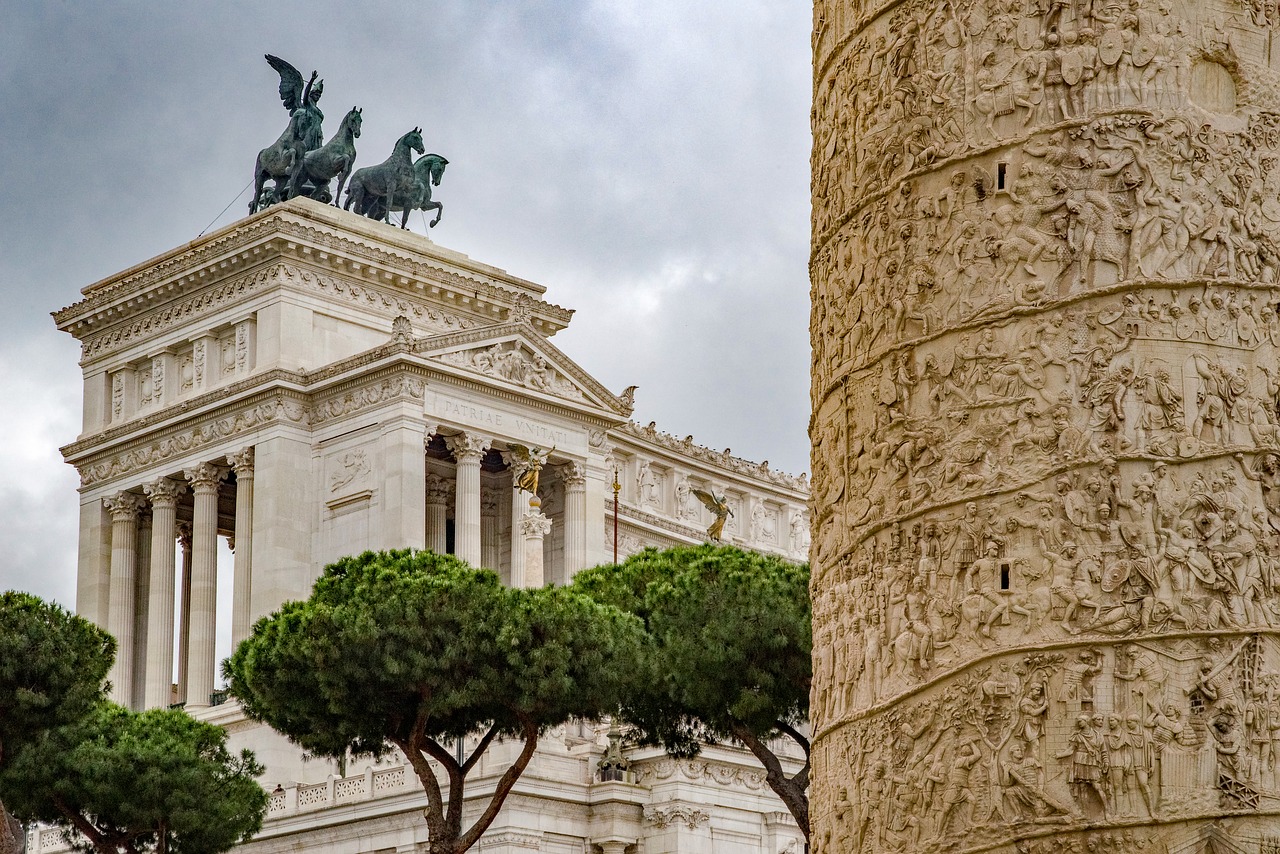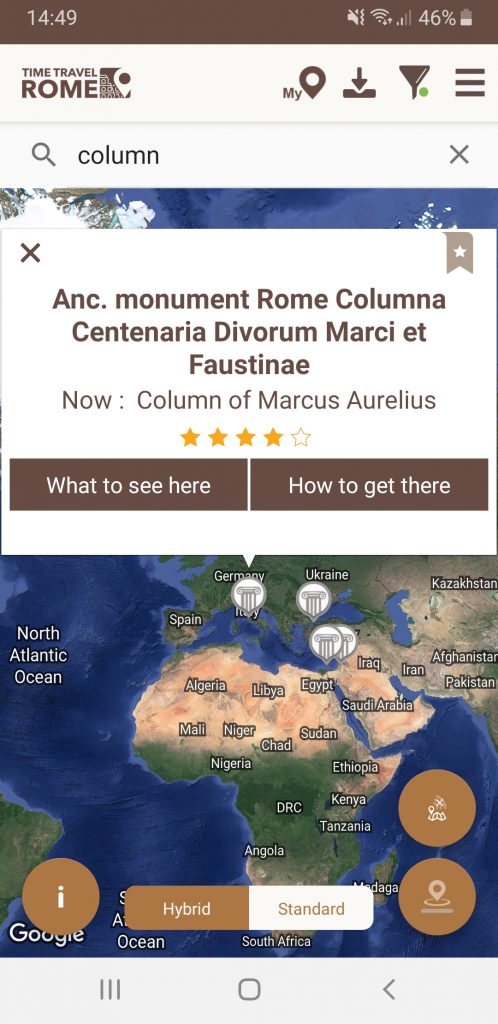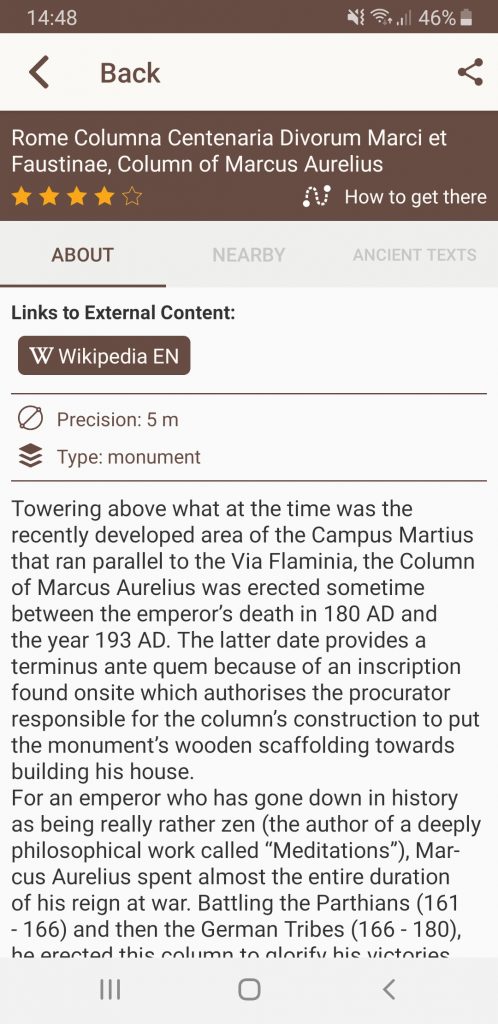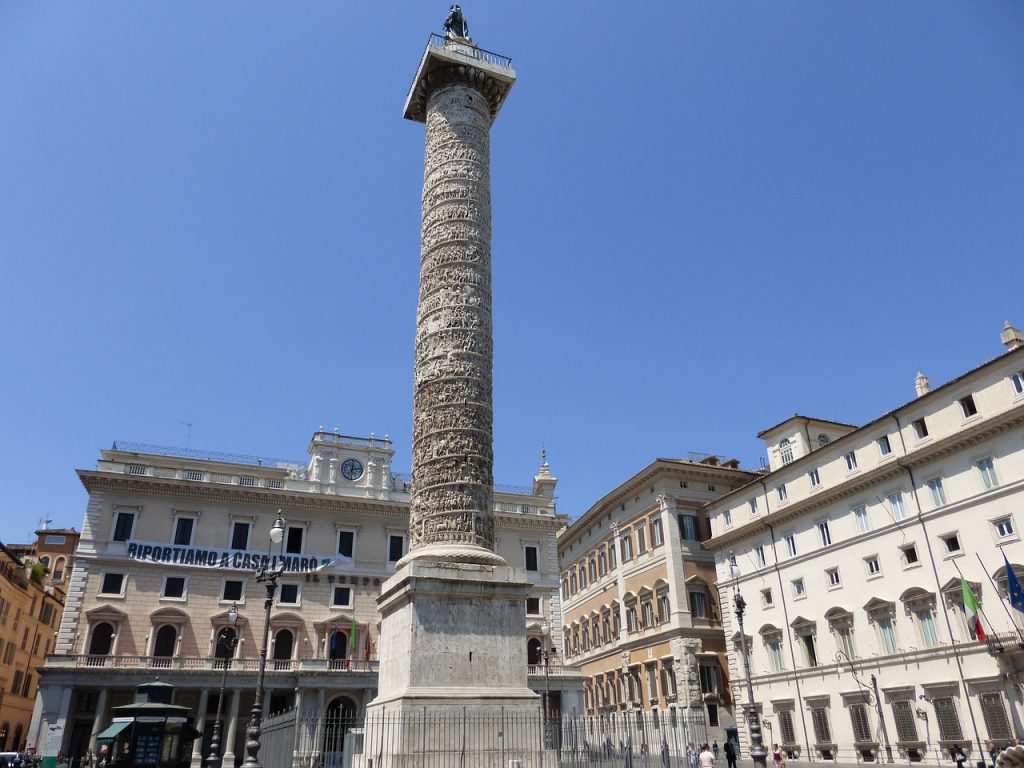In 1776, Edward Gibbon published his massive, six book, History of the Decline and Fall of the Roman Empire. In it he popularized Niccolò Machiavelli’s classification of the “Five Good Emperors.” Though a subjective opinion, the five emperors who took power via adoption stand out as wise and just rulers. Their reigns marked the Golden Age of Rome. This post offers a short history of their rule, but also suggests some emblematic monuments related to their rule.
Nerva
Some modern historians think of Nerva as a weak and hesitant committee man. In reality, he was clearly clever and shrewd; simply wise enough to seek the counsel of others. He navigated the political quagmire of Rome and enjoyed a successful career while remaining close to six successive emperors during chaos and civil war. He is the only person besides Vespasian’s own son Titus to serve as the Emperor’s co-consul. When conspirators in the Senate planned Domitian’s murder, they had already chosen Nerva as his successor.

A proven statesman, Nerva re-built the trust of both the people and the Senate and forestalled another civil war. He was well into his sixties, often ill, and physically weak, with no natural children; a perfect placeholder. The army and the Praetorian Guard were the only unpredictable factions. Nerva’s choice of successor, the shrewd and highly popular general Trajan, ensured full support. He only reigned for fifteen months, but managed to institute popular policies and launch important building programs. He was remembered fondly by his contemporaries.
What Site is most closely related with Nerva? We think it is the eponymous Forum in Rome. Often disregarded by tourists, the Forum of Nerva was the fourth and smallest of the imperial fora, but it still reminds us of the legacy of the first of the “good” Emperors of Rome.
Trajan
Trajan was a perfect Emperor to follow Nerva. He was the ideal Roman; ambitious, skilled in politics and military strategy, restlessly expansionist, yet also kind and fair. Trajan was equally an emperor and a general. He led his armies on the battlefield, and the Empire reached the height of its size during his rule. His soldiers adored him. He would spend the first hours after a battle visiting with the wounded among his men. During one such visit, the army medics ran out of bandages. Trajan immediately cut up his own clothing into strips and offered it to them to dress the soldier’s wounds.
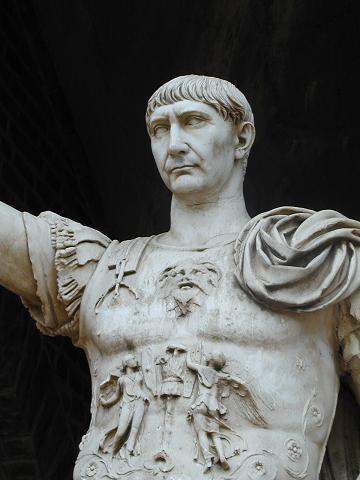
He was equally tactful in his administrative work. He maintained a high level of respect for the Senate and for the old customs of the Republic. The people praised his work to fix the crumbling Roman roads and public buildings. His many social and economic reforms were equally popular. One of these was among the first public welfare programs in history, designed to aid poor and orphaned children. He did all of this without exploiting Roman citizens or provincials. Every ancient source compliments Trajan. He was just, brave, humble, mild, generous, hard-working, trusting, and fiercely loyal. When his cousin died, Trajan adopted the man’s children, Hadrian and Paulina, and he later named Hadrian his heir.
What Site is most related with Trajan? An excellent choice would be Trajan’s Column, constructed in 113 A.D. and commemorating his victories in Dacia. Curiously it served as archetype for later rulers – for Marcus Aurelius and also for Napoleon, who used Trajan’s Column as a template for the depiction of his own military achievements, represented by the Vendôme Column that stands in Paris.
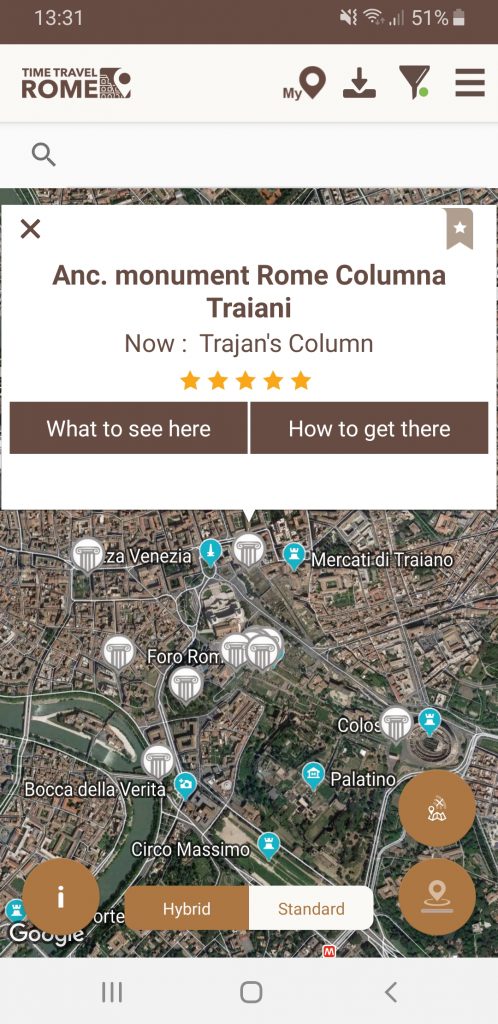
Time Travel Rome 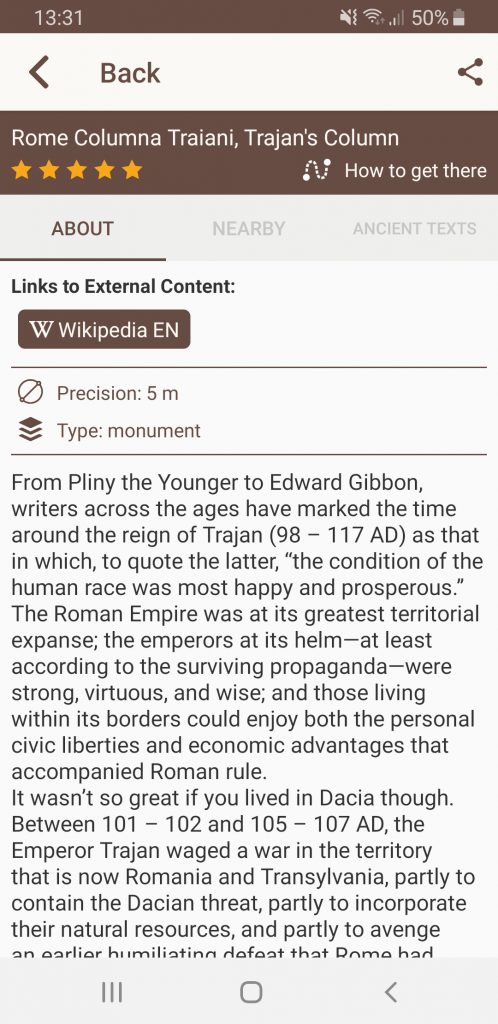
About 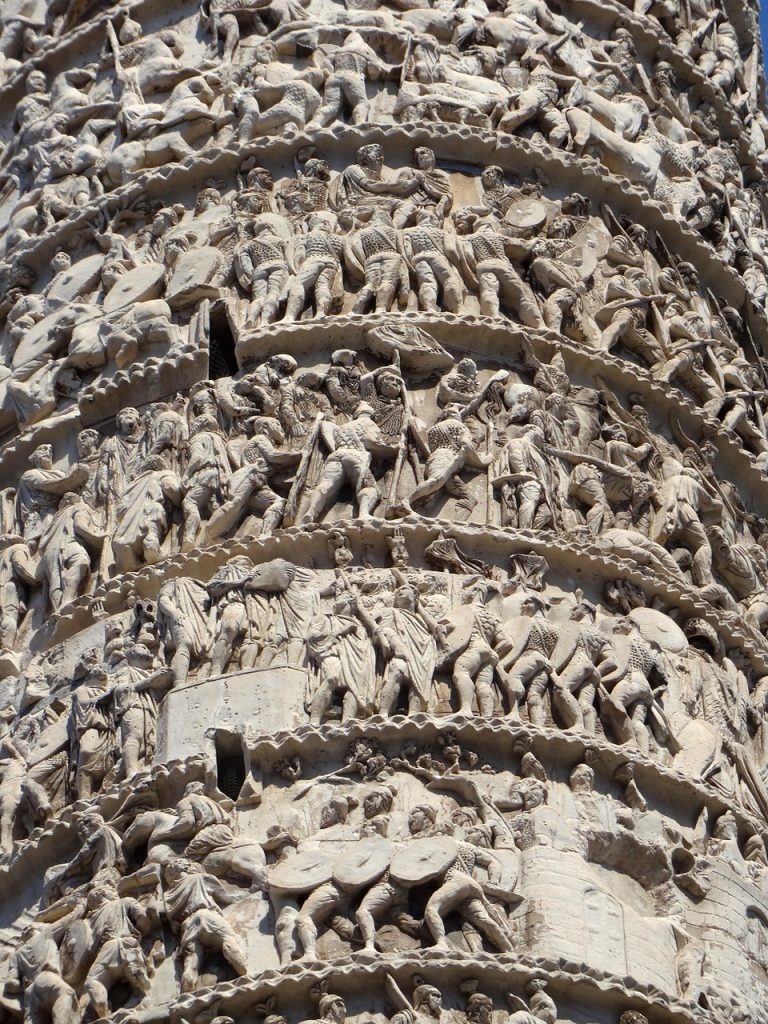
Trajan’s Column by SCAPIN is licensed under CC0
Hadrian
Coming after Trajan, Hadrian’s complex personality often confused his contemporaries. He frequently ran contrary to Roman ideals, preferring defensive strategy to imperialism and expansion. Early in his reign, he earned the suspicion of the Senate, and he was never able to escape that. He was generally friendly and kind, treating people with respect and even visiting ill friends personally. Yet, unlike the firm loyalty of Trajan, several times he suddenly dropped formerly favored friends for no obvious reason. He was confident almost to the point of arrogance in his many interests and hobbies, intelligent, decisive, and charismatic. Yet he never displayed the fragile ego of many other Emperors, who would lash out viciously against critics.
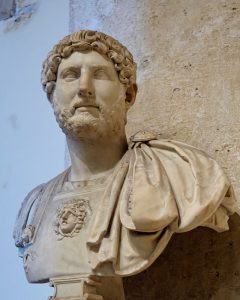
Once a woman approached him, and he brushed her off impatiently, saying he had no time for her. She shot back, “well, stop being emperor, then!” Where many might have had the woman punished for insolence, Hadrian humbly took the barb to heart. He stopped to allow her an audience. Despite his brash and assured public face, Hadrian maintained a deep need for seclusion. His private rooms at his villa sat on a small island in the middle of a pond, accessible only by rowboat. Despite his contemporaries’ doubts, the Empire prospered under Hadrian, and he deserves his place among the five great emperors. Today, he is best remembered for the ruins of the ancient wall in England that bears his name.
What Site is most representative of Hadrian’s rule? We suggest it could be the Hadrian’s Wall in northern England. It ran from the North Sea to the Irish Sea with a fort every five Roman miles. The Wall effectively reflects Hadrian’s time: splendor and magnificence in Rome, but tempered by the emerging existential threat on the frontiers of the Empire.
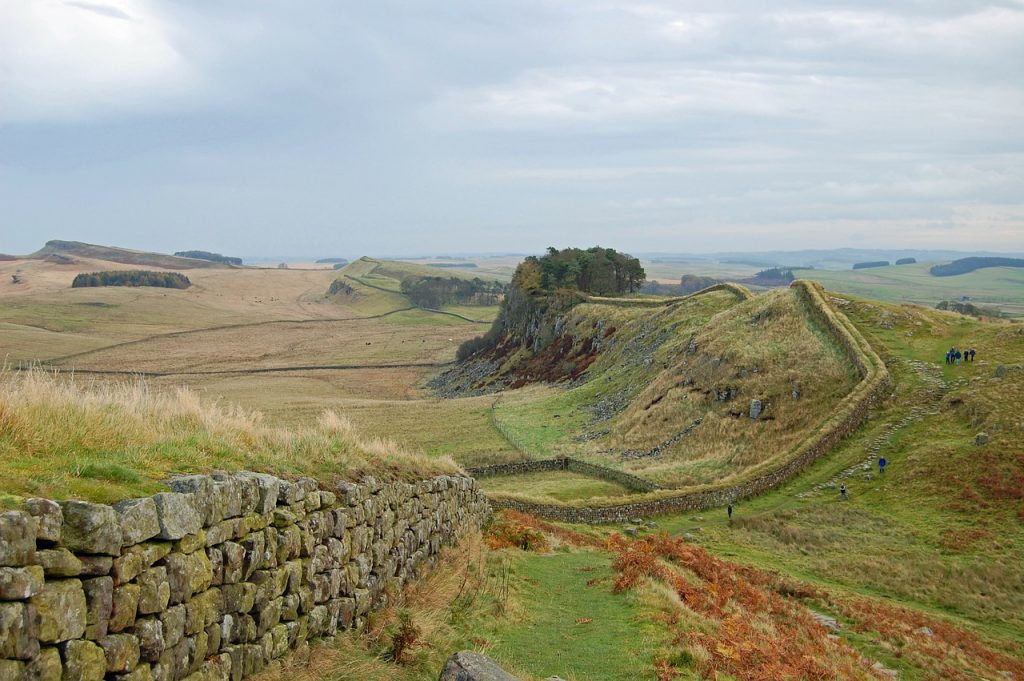
Antoninus Pius
Chosen mainly as a placeholder, Antoninus Pius was already middle-aged when Hadrian picked him as his successor. Hadrian’s favorite was still too young, and the Emperor was growing ever sicker. He appointed Antoninus his successor, if he would adopt Marcus and another boy, Lucius Verus, next, as joint heirs. Antoninus stayed strongly loyalty to Hadrian, remaining by his side to the very end. He then stood up to the Senate when they refused to deify Hadrian just after the Emperor’s death. Antoninus threatened to resign, and they finally agreed.
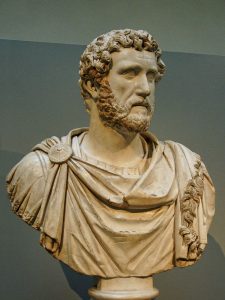
He was a beloved ruler, never much for war, instead holding a deep regard for life. His character was flawless. He refused any bribes, and met all problems brought to him with the same focus. The status of the suppliant did not matter. He was humble, cheerful, prudent, wise, and had a soft heart. Antoninus and Marcus loved one another dearly. Marcus began to rule jointly with his adopted father toward the end of his life.
What Site is most closely related with Antoninus Pius? It is probably the Temple of Antoninus and Faustina in Rome. The temple was initially dedicated only to Antoninus’s deceased wife, Faustina the Elder. When the Emperor was deified by the Senate after his own death, the temple was re-dedicated to both himself and his wife. Antoninus and Faustina are believed to have enjoyed a happy marriage and the Temple still reminds us of their happy union.
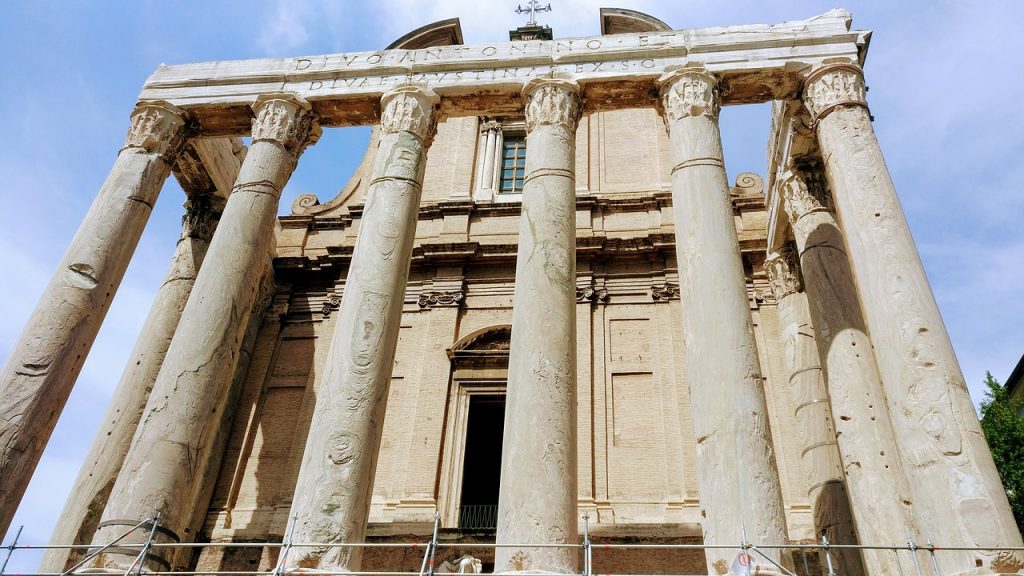
Marcus Aurelius
Perhaps the greatest ruler of all time, Marcus Aurelius did not even want to become emperor. Serious and smart, he had devoted himself to Stoic philosophy from a young age. When told he was to be the adopted heir, he was furious, but eventually agreed. He ruled as co-emperor with his adopted brother Lucius Verus, until the latter died while on campaign. No other emperor is praised as highly as Marcus Aurelius. Cassius Dio named him the best Emperor in the history of Rome. He was pleasant, deeply kind-hearted, and hated violence. During his rule, he would not even allow gladiators to fight with real weapons. Though frugal, he was still generous to his subjects, forgiving, and also very respectful of the Senate.
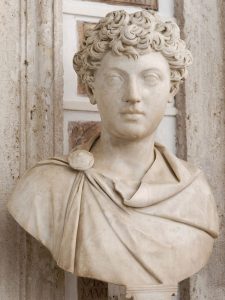
He was the perfect philosopher king. His only failure was that he produced a natural son. The Five Great Emperors had all been chosen deliberately for their abilities and character, and adopted to ensure succession. Upon Marcus Aurelius’s death, his vicious son Commodus became emperor. Cassius Dio says that it degraded Rome “from a kingdom of gold to one of iron and rust.”
What Site would we associate with Marcus Aurelius? Perhaps the most well-known is his famous Column in Rome, completed in 193 A.D. It was made of Carrara marble and dedicated to his victories over the Sarmatians and Germanic tribes. Marcus Aurelius is seen as the last emperor of the Pax Romana, an age of peace and prosperity for the Empire. His Stoic philosophy, which can be read in his personal journal, now published as Meditations, have been praised for centuries.
We have proposed our ideas of the iconic sites that most represent the five “Good Emperors” of ancient Rome. Do you have other ideas? Share your thoughts with us!
Sources: Cassius Dio, Roman History ; Sextus Aurelius Victor, Epitome De Caesaribus ; Marcus Aurelius, Meditations ; Historia Augusta
Photo: Hadrian Column by
